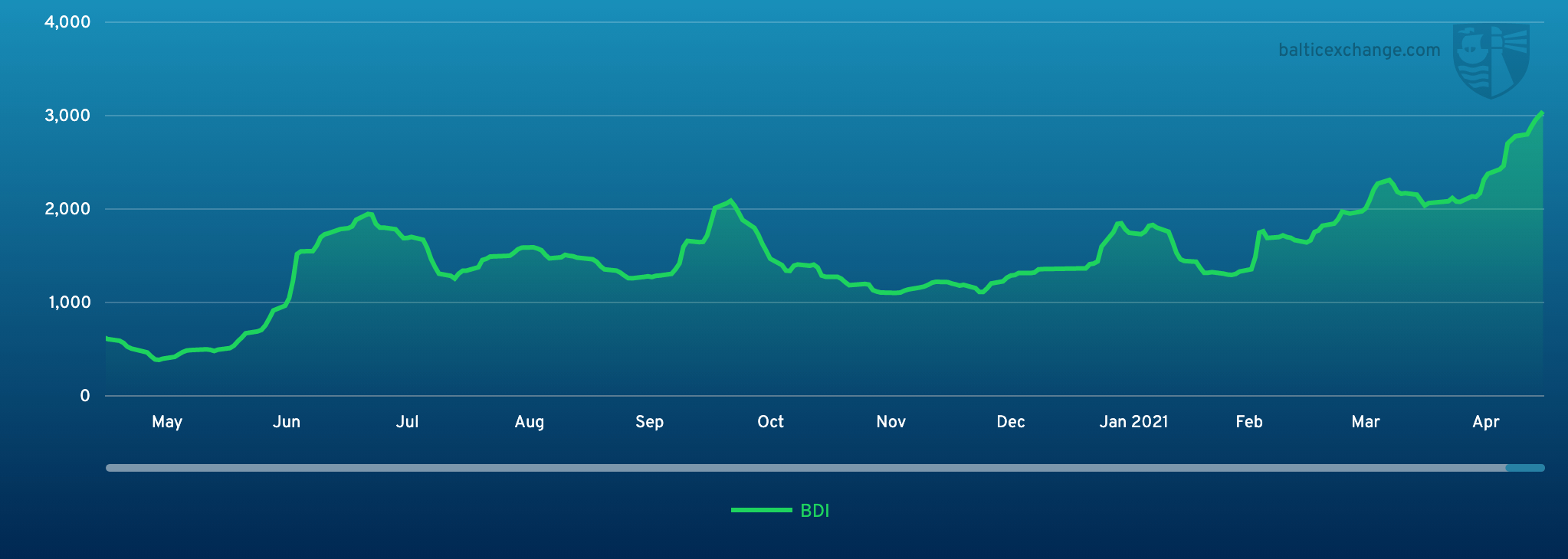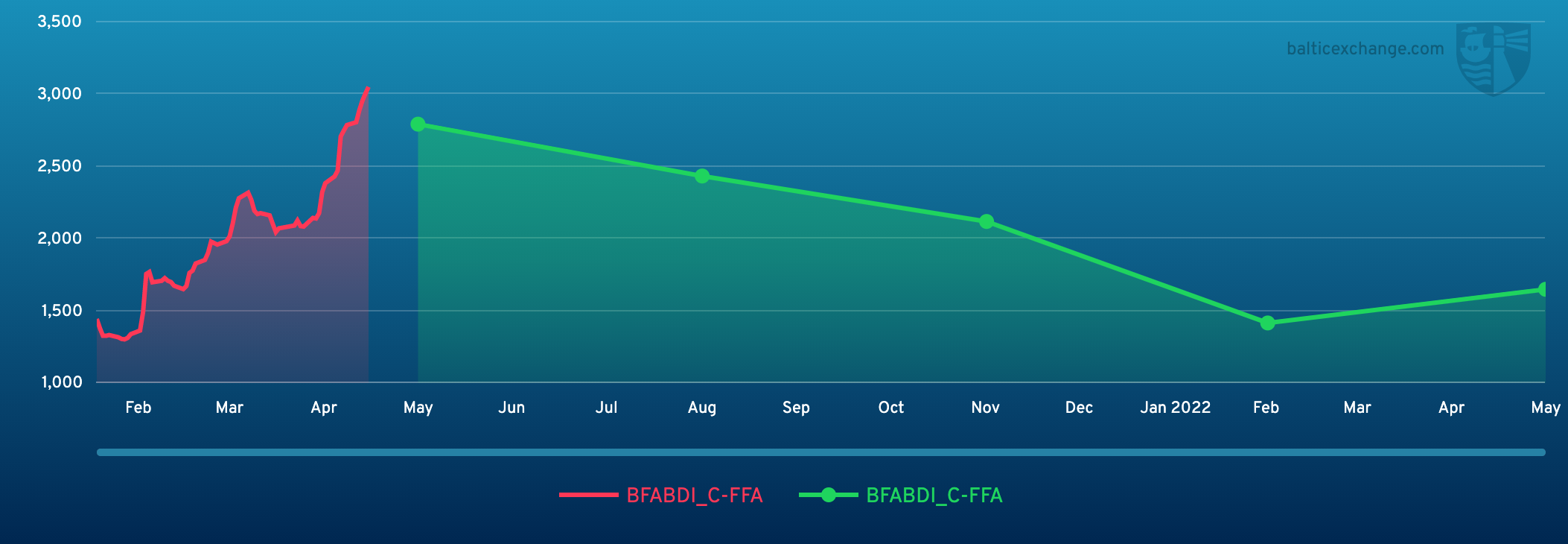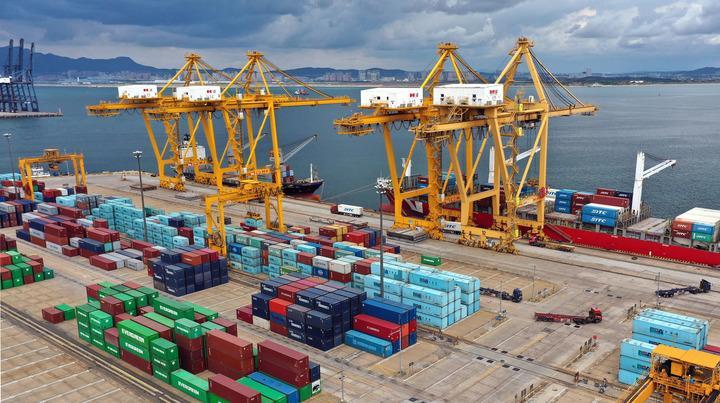BEIJING, May 6 (Xinhua) -- The Baltic Exchange has published its weekly report of the dry and tanker markets for April 26-30, 2021 as below:
Capesize
The market is showing no signs of easing as rates continued to ascend this week reaching record highs for the 5TC average at $40,608. To be reminded of when these levels were last reached, the Capesize market traded under the 4TC routes and it was late Q3 2013. This week a stronger lift was realized from the trans Pacific C10 moving up $7,988 to $40,692, while the trans Atlantic C8 remains the premium-paying basin gaining $5,150 to $42,600. With relatively static bunker prices this week, it appears these gains are purely coming from the demand for shipping. Underpinning the demand was iron ore prices continuing to climb, now at a lofty $192 pmt as steel demand remains strong. Out of West Australia on the C5 route to Qingdao freight is now priced at $13.241, which is up $1.691. A shorter week due to UK May bank holiday on Monday, as well as Golden Week holidays in several Asia countries may dampen some market activity. However, it may be unlikely to have any lasting effect on this supported Capesize rally.
Panamax
A lethargic start to the week in the Atlantic as the Panamax market saw little in way of trans-Atlantic enquiry, the north appeared mainly fronthaul centric with strong grain and mineral demand from NC South America and US Gulf. Some APS load port trans-Atlantic fixtures reported Monday/Tuesday but a sudden push midweek - with suggestions of a possible FFA/Cape correlated influence - appeared to level off Thursday as we approached the long weekend with various upcoming holidays. EC South America fixtures were solid, if not spectacular overall, with a steady flow throughout the week. Asia began active especially from Australia and Indonesia, Indonesia round trips hovering all week around the upper $20,000’s and $30,000 mark. NoPac was sluggish all week an 82,000dwt delivery Japan achieving $26,750 midweek but little else emerged. Period rates appeared healthy, particularly off the back of FFA gains midweek. An 82,000dwt delivery China achieved $23,000 for seven to 10 months period charter.
Ultramax/Supramax
The main focus during the early part of the week was in the Asian market, where rates still maintained healthy levels. In the Atlantic, demand appeared to ease due to limited fresh enquiry, which was perhaps a consequence of the impending holidays in both the U.K and Asia next week. There was still some period activity with a 63,000dwt open north China fixing for one year at $21,000. In the south Atlantic, pressure eased slightly. An Ultramax fixing in the region of $19,850 plus a ballast bonus around $985,000 for a trip delivery east coast south America to south east Asia. Elsewhere, a 55,000dwt fixed delivery west Africa for a trip to Black Sea at $20,000. From Asia, rates remained firm a 56,000dwt open Ningde fixing a coal run via Indonesia to China at $26,000, whilst a 63,000dwt open Philippines fixed a trip via Indonesia to Thailand at $30,000. The Indian Ocean still maintained good levels a 61,000dwt fixing a trip from east coast India to China at $31,000.
Handysize
The Asia markets made large upward moves this week, which some brokers felt was due to a lack of available tonnage. The Atlantic showed signs of stalling, with impending holidays in parts of Europe being a possible reason. Period activity continued, in Asia a 37,000dwt open China fixed four to six months at $23,000 with worldwide redelivery, whilst in the US Gulf a 37,000dwt fixed four to six months at $17,500 for Atlantic Redelivery. On the shorter trips, a 38,000dwt was rumoured to have fixed a trip from Thailand via Indonesia to China at a higher level of $24,000 and a 36,000dwt fixed from Vietnam to the US West Coast with bulk cement at $31,000 as the cargo often commands a premium. A 38,000dwt open in South Korea was rumoured to have fixed a trip to the Continent at $24,000. Rates from east coast South America for trans Atlantic were fairly static. A 38,000dwt from river Plate to the Continent-Mediterranean was fixed at $21,000.
VLCC
Rates for Middle East to US Gulf trip (routing via the Cape/Cape) moved up a shade (half a point) to WS19.5 level while rates for 270,000mt to China have risen a modest 1.5 points to just over WS35 showing a round-trip TCE of about $2,000/day. In the Atlantic, rates for 260,000mt West Africa to China rose six points to WS40 (TCE of about $8,800/day) and 270,000mt from US Gulf to China saw rates add about $250k to $4.55m (about $8,500/day TCE).
Suezmax
In the 135,000mt Black Sea/Med market rates have eased four points to WS61.5 (a negative round-trip TCE of $1,600k/day) while for 130,000mt Nigeria/UK-Continent levels dipped 3 points to WS55 (appox $3,400/day TCE) and for 140,000mt Basrah/Med it fell a single point to WS19.5 level.
Aframax
In the cross Mediterranean market, rates firmed with 80,000mt Ceyhan/Lavera gaining 14 points to WS90 (a TCE of about $4,500/day). In Northern Europe 80,000mt Cross-North Sea firmed a couple of points to WS88 (negative $2,600/day TCE), while rates for 100,000mt Baltic/UK-Continent again rose about 3.5 points to the WS68 mark (about $2,800/day TCE). On the other side of the Atlantic the market fell back again after the recent rise, with rates for 70,000mt Caribbean/US Gulf dropping 14 points to WS93 (a TCE of about $3,500/day), while for 70,000mt US Gulf/UK Continent rates lost 15 points to the WS80 level.
Clean
The start of the week saw rates drop just over eight points to very low WS70s for LR2 tonnage on Middle East Gulf/Japan route. After a modest improvement in the latter half of the week, where Marubeni paid in the region of WS74, we hear today WS70 is again reportedly agreed and a coated newbuilding is said to have gone at WS66.5. The LR1 market was more stable with rates hovering at, or very close to WS105, with signs of potentially downward pressure due to some Charterers moving up to LR2 tonnage. In the MR market, 35,000dwt clean into East Africa was being fixed early in the week at around WS140 - and this was on tonnage over 15 years old. Subsequently, Owners have been unwilling to consider such level. Rates are assessed higher in the WS150s, with one Owner said to be unwilling to break WS165. For Continent to USAC it was an uneventful week, with rates creeping up modestly. There was one fixture reported at WS115, but otherwise levels have been ticking over at around WS110 with West Africa runs generally paying 10 points more. The backhaul (Houston/Amsterdam) rate spluttered briefly into life with more naphtha enquiry pushing up rates from very high WS60’s to between WS72.5/75 region. For runs into Brazil the market was flat at or close to around WS110. It was another disappointing week for handies on cross Med as rates continued to slide, but perhaps have now bottomed out at WS130, which is about eight points lower than the start of the week.
Headquartered in London and a subsidiary of the Singapore Exchange (SGX), the Baltic Exchange publishes a range of indices and assessments which provide an accurate and independent benchmark of the cost of transporting commodities and goods by sea. These include the Baltic Dry Index (BDI), the dry bulk shipping industry's best known indicator. Published daily since 1985, this provides a snapshot of the daily spot market earnings of capesize, panamax and supramax vessel types on the world's key trading routes.

Chart shows Baltic Dry Index (BDI) during May 1, 2020 to April 30, 2021

Baltic Forward Assessment for BDI
In March 2018 the BDI was re-weighted and is published using the following ratios of timecharter assessments: 40 percent capesize, 30 percent panamax and 30 percent supramax. The information is provided by a panel of international shipbrokers.
(Source: The Baltic Exchange, edited by Niu Huizhe with Xinhua Silk Road, niuhuizhe@xinhua.org)




 A single purchase
A single purchase









